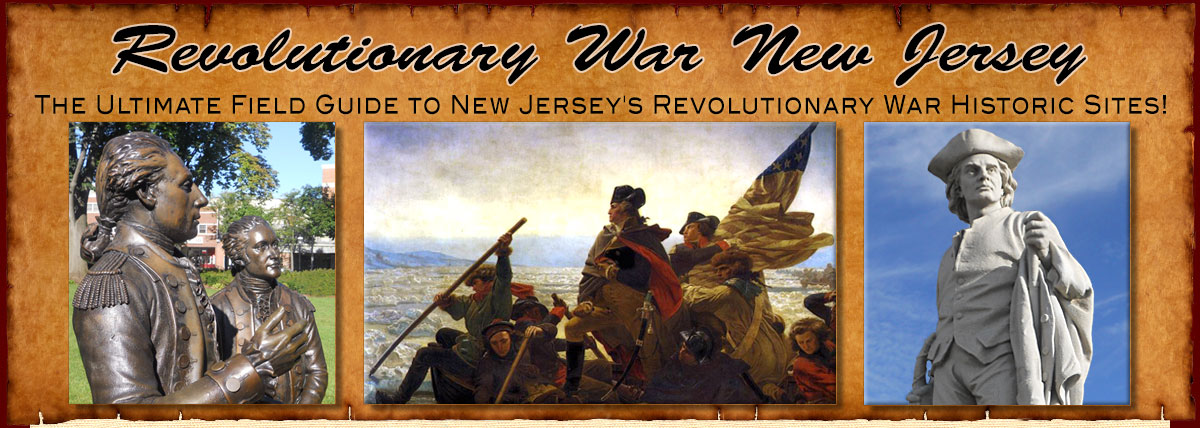

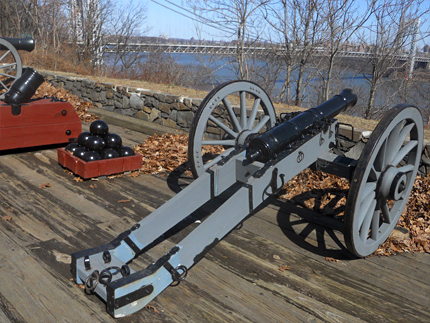
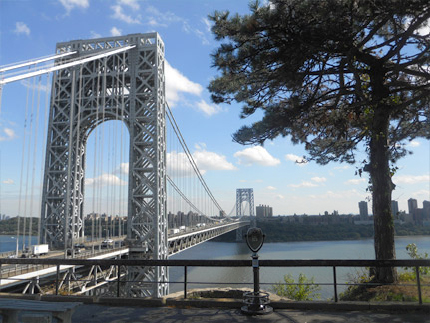
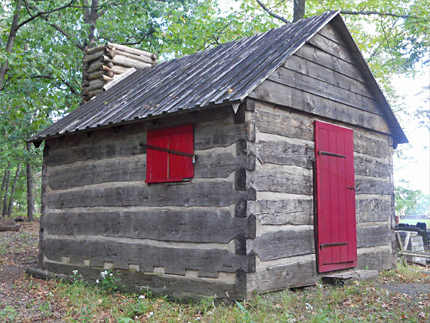
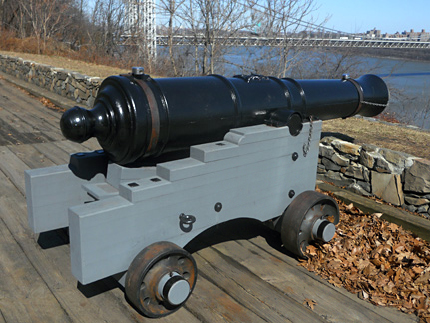
Fort Lee Historic Park
Hudson Ter.
Map / Directions to Fort Lee Historic Park
Map / Directions to all Fort Lee Revolutionary War Sites
For current hours and admission information, see the Fort Lee Historic Park Website
April - November 1776
Brooklyn, Manhattan, Fort Washington, and Fort Lee [1]
George Washington was named the head of the Continental (American) Army by Congress on June 15, 1775. His first task was to travel to Philadelphia from Boston, where a successful siege which drove British forces from the city was an early victory. The next chapter would prove to be much more difficult, and nearly disastrous to the Continental Army.
After British forces were driven from Boston in March 1776, General Washington headed to New York City, where he arrived on April 13, 1776. The task for him and his army was to protect New York from British invasion. The city was of great strategic importance, and New York harbor offered control of the Hudson River. The British had a large and powerful navy, and their strategy was to use their ships to gain control of the Hudson River in order to split the thirteen colonies in two.
On June 29, British ships began arriving in the New York harbor. Over the next two months, a steady stream of additional ships would arrive, carrying more and more British and Hessian troops. (Hessians were German mercenary soldiers hired by the British to fight in the war.)
While the main body of Washington's army was on Manhattan and Long Island, work began on a fort here in July 1776, which was originally called “Fort Constitution.” It would later be renamed “Fort Lee” in honor of General Charles Lee. Across the Hudson River, another fort called Fort Washington had already been constructed. The idea was that these two forts on opposite sides of the river could be used to stop British ships from sailing up the Hudson River.
On July 4, the Declaration of Independence was adopted by the Continental Congress in Philadelphia, raising the stakes of the war. British ships continued to sail into New York harbor throughout the summer, bringing a total of more than 31,000 British and Hessian troops. This was the largest invading force in history up to that time. As the British and Hessian forces continued to grow on Staten Island, General Washington was uncertain as to where they would attack first. He therefore kept some of his troops on Manhattan Island and some in Brooklyn on Long Island.
The first test for the effectiveness of Fort Washington came when two British ships, the Rose and the Phoenix, sailed up the Hudson River on July 12. Cannon fire from Fort Washington made little impact; the two ships suffered no serious damage, and no casualties. Despite these poor results, General Washington stuck to the plan of defending the river with the forts, and so work continued to complete Fort Lee.
The initial attack by British and Hessians came on Long Island on August 22, in which the Americans were forced to evacuate defenses they had spent months building. Over the following weeks, the Continental Army suffered a series of defeats and retreated north across Manhattan. By the end of September, British were in control of all of Manhattan, except Fort Washington.
The decision was made to defend Fort Washington, even though its effectiveness had been shown to be ineffective in its purpose of stopping British ships from sailing past it on the Hudson River.
On November 16, British and Hessian troops attacked Fort Washington, easily and quickly overrunning its defenses and capturing 2,800 American troops. Washington ordered General Nathanael Greene to manage an evacuation of Fort Lee, while Washington himself was headquartered ten miles away at the Zabriskie house in Hackensack. [2] A surprise invasion several days later would keep the evacuation from being an orderly one.
On the night of November 19-20, 5000 British and Hessian forces under General Cornwallis crossed over the Hudson River, disembarking about six miles north of Fort Lee at Lower Closter Landing. Upon learning of the invasion, the American troops at Fort Lee made a hasty evacuation, leaving behind such important items as tents, entrenching tools, heavy artillery, and a large amount of food. This began a twelve-day retreat across New Jersey, arriving on December 2 in Trenton, where they spent five days moving all the troops and supplies across the Delaware River into Pennsylvania. (See the Bergen County 1776 Retreat Route Signs entry lower on this page.)
This was a desperate time for General Washington and his army, what Thomas Paine would describe as "These are the times that try men's souls." [3] Washington himself wrote in a letter to his brother John after the fall of Fort Washington, "I am wearied almost to death with the retrograde motion of things." [4]
More bad news followed. The army's second ranked General, Charles Lee, for whom Fort Lee was named, was captured by the British in Basking Ridge on the night of December 12 - 13. [5]
However, within weeks Washington and his army would turn the tide. On Christmas night, Washington's forces crossed the Delaware River back into New Jersey and win a small but important victory the next morning at Trenton, followed a week later by another victory at Princeton. Having revived their chances and morale, Washington's army headed to Morristown where they spent the winter.
From this point on, New Jersey would play a major role in the Revolutionary War, and Washington would spend more time in this state than any other. Important events in New Jersey over the next six years include encampments in Morristown and Middlebrook; the Battles of Monmouth, Connecticut Farms, and Springfield; as well as many other major and minor events. In 1783, the Treaty of Paris was signed, officially ending the war. When the news of the signing reached America, Congress was meeting in Nassau Hall in Princeton, and General Washington was headquartered in Kingston. Given New Jersey's significant role in the Revolutionary War, it was fitting that both General Washington and Congress were in New Jersey at the time they received this momentous news. [6]
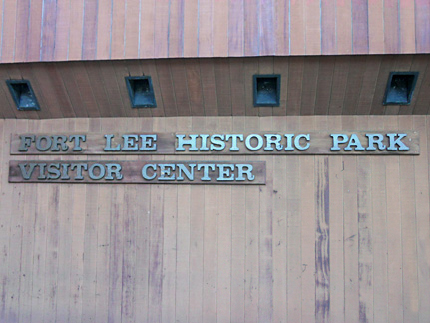
The Visitor Center contains two floors of exhibits which explain and interpret the historic events which occurred at Fort Lee in 1776.There is also a small gift/book shop.
One of the most helpful exhibits is a large three-dimensional map of the New York/Fort Lee area titled "The New York Campaign." The exhibit combines narration with lights on the map which represent the movement of troops across the terrain of the area. When visiting Fort Lee, I highly recommend using this exhibit to understand the geography and troop movements of events in New York and Fort Lee in 1776.
In addition to the information and exhibits available at the Visitor Center, there are signs placed throughout the park grounds to describe the history of this site. There are also soldier hut recreations, and cannons. The view from the park of the Hudson River, New York City, and the George Washington Bridge are outstanding.

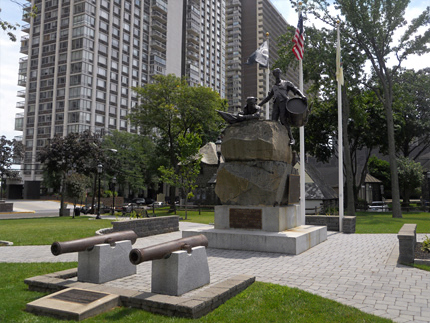
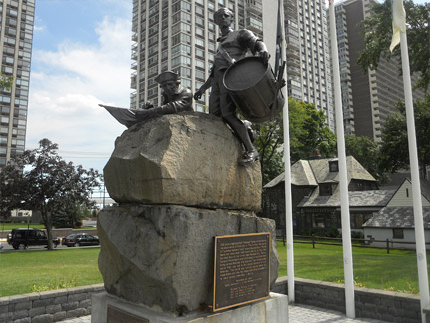
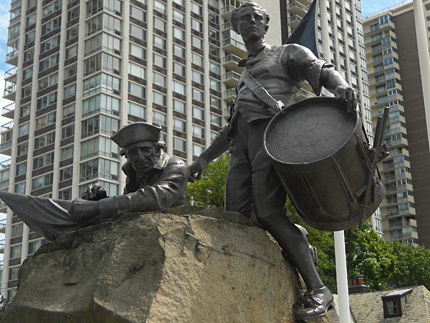
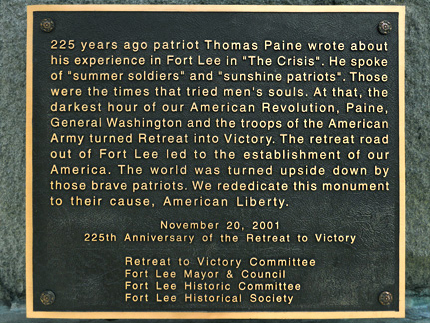
Monument Park
Palisade Ave. and Monument Pl.
Map / Directions to Monument Park
Map / Directions to all Fort Lee Revolutionary War Sites
Monument Park was created by the Daughters of the American Revolution in 1908. At the park's dedication ceremony, the keynote speaker was General John "Black Jack" Pershing, who would go on to lead the American Expeditionary Forces in World War I. [7]
The centerpiece of Monument Park is the majestic Rebelmen statue shown above. In addition to this statue, there are historic plaques located throughout the park. Two plaques describe the use of surrounding Fort Lee roads by the troops in 1776. Others are dedicated to individual Revolutionary War Generals who played a role in the events in Fort Lee.
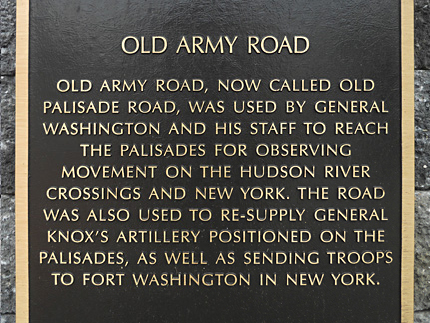
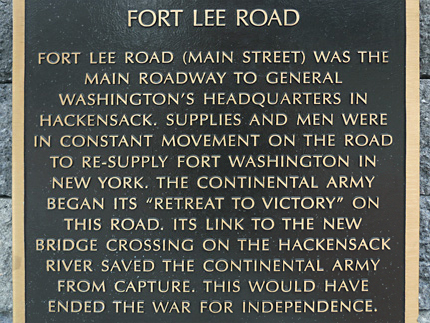
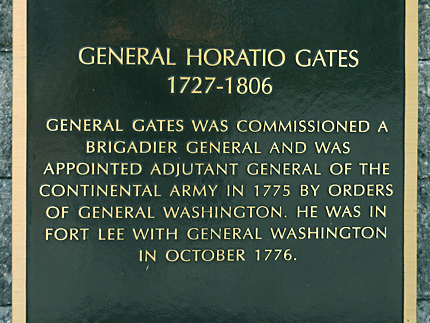
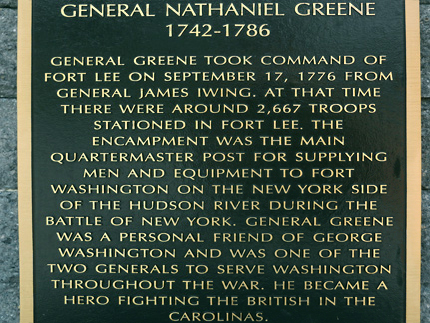
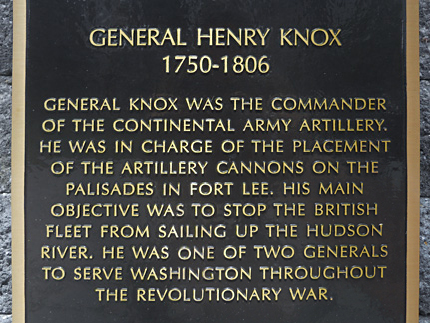
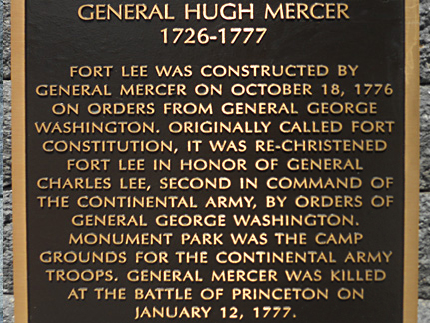

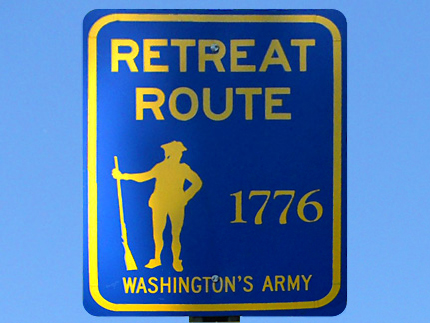
Bergen County 1776 Retreat Route Signs
Running from Fort Lee Historic Park
to Acquackanonk Bridge in Wallington
Bergen County Retreat Route Sign Path - Part 1
(From Fort Lee to New Bridge Landing)
Bergen County Retreat Route Sign Path - Part 2
(From New Bridge Landing to Acquackanonk Bridge in Wallington)
Washington's Army 1776 Retreat Route signs are posted throughout Bergen County along the retreat route taken by the army after abandoning Fort Lee on November 20, 1776. These signs can be followed through Bergen County from Main Street in Fort Lee to Acquackanonk Bridge in Wallington.
Washington's Army reached the Acquackanonk Bridge in Wallington on November 21. They continued their retreat across New Jersey, through Newark, New Brunswick, and Princeton, finally reaching Trenton on December 2. The next five days were spent moving all of the troops and supplies in small boats over the Delaware River into Pennsylvania. They made their famous Crossing of the Delaware back into New Jersey several weeks later on Christmas night.

1. ^ A variety of sources were consulted in preparing this entry, including:
• David McCullough, 1776 (New York: Simon & Schuster, 2005)
• David Hackett Fischer, Washington's Crossing (New York: Oxford University Press, 2004)
• Markers, signs, brochures and exhibits at Fort Lee Historic Park
• George Washington; Edited by Jared Sparks, The Writings of George Washington Volume 4 (Boston: Russel, Odiorne and
Metcalf; and Hilliard, Gray, and Co., 1834) Available to be read at Google Books here2. ^ Note that using modern roads, the distance is only eight miles from the Fort Lee encampment to Zabriskie's house site in Hackensack. However, in 1776 the journey was longer because it was necessary to use the New Bridge to cross the Hackensack River.
3. ^ "These are the times that try men's souls" is the opening sentence of Thomas Paine's The Crisis.
4. ^ George Washington to John Augustine Washington, sent from "Hackinsac" [Hackensack] on November 19, 1776, reprinted in:
George Washington; Edited by Jared Sparks, The Writings of George Washington Volume 4 (Boston: Russel, Odiorne and Metcalf; and Hilliard, Gray, and Co., 1834) pages 182 - 185 Available to be read at Google Books here5. ^ General Charles Lee was captured at Widow White's Tavern in Basking Ridge by a group of British dragoons (cavalry) under the command of twenty-two-year-old officer Banastre Tarleton.
▸ For more information, see the Basking Ridge page of this website.6. ^ For more information and accompanying source notes about the events mentioned in these two paragraphs, see the pages linked to within the text.
7. ^ Official Website of the Borough of Fort Lee and the General John 'Black Jack' Pershing plaque in the park.